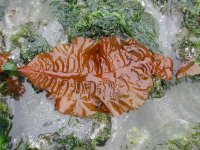Laminaria sugary (sea kale)
Laminaria saccharina (L.) Lamour.
Botanical characteristics. The family is laminar. Seaweed reaching a length of 13 m. The thallus is wide, brown in color, consists of plates, trunk and base, attached to the seabed with the help of rhizoid-root formations. It reproduces sporangia, which are formed from July to October.
Spread. Forms extensive thickets in the northern and far eastern seas of the country, prefers stony soil. In addition to laminaria, sugary, for food and medicinal purposes, it produces laminaria and palm laminaria.
Used parts of the plant.
Plate parts of the thallus.
In sea kale, a lot of iodine (up to 3%) and bromine, it contains vitamins, alginic acid, mannitol, laminarin and trace elements (sodium, potassium, calcium, magnesium, copper, cobalt, arsenic).
Application.
It is largely due to the content of iodine and vitamins in sea kale. For many centuries, kelp is used in China and Japan for the prevention and treatment of thyroid diseases, as a restorative and life-prolonging remedy.
It is used for the prevention and treatment of atherosclerosis, with gout, with thyrotoxicosis, as a mild laxative.
The sea kale powder in the experiment has a retarding effect on the growth of malignant tumors.
Contraindications.
Diseases in which iodine preparations are not recommended: nephrosis-nephritis, hemorrhagic diathesis, urticaria, chronic skin rashes, pregnancy, chronic rhinitis and tuberculosis.
With prolonged use in large doses, kelp can cause phenomena of iodism.
Preparation. 1/2 teaspoon of grass powder taken at night, washed down with water (daily dose). You can sprinkle salad and vegetable dishes with laminaria (1/2 teaspoon per day).




Comments
When commenting on, remember that the content and tone of your message can hurt the feelings of real people, show respect and tolerance to your interlocutors even if you do not share their opinion, your behavior in the conditions of freedom of expression and anonymity provided by the Internet, changes Not only virtual, but also the real world. All comments are hidden from the index, spam is controlled.